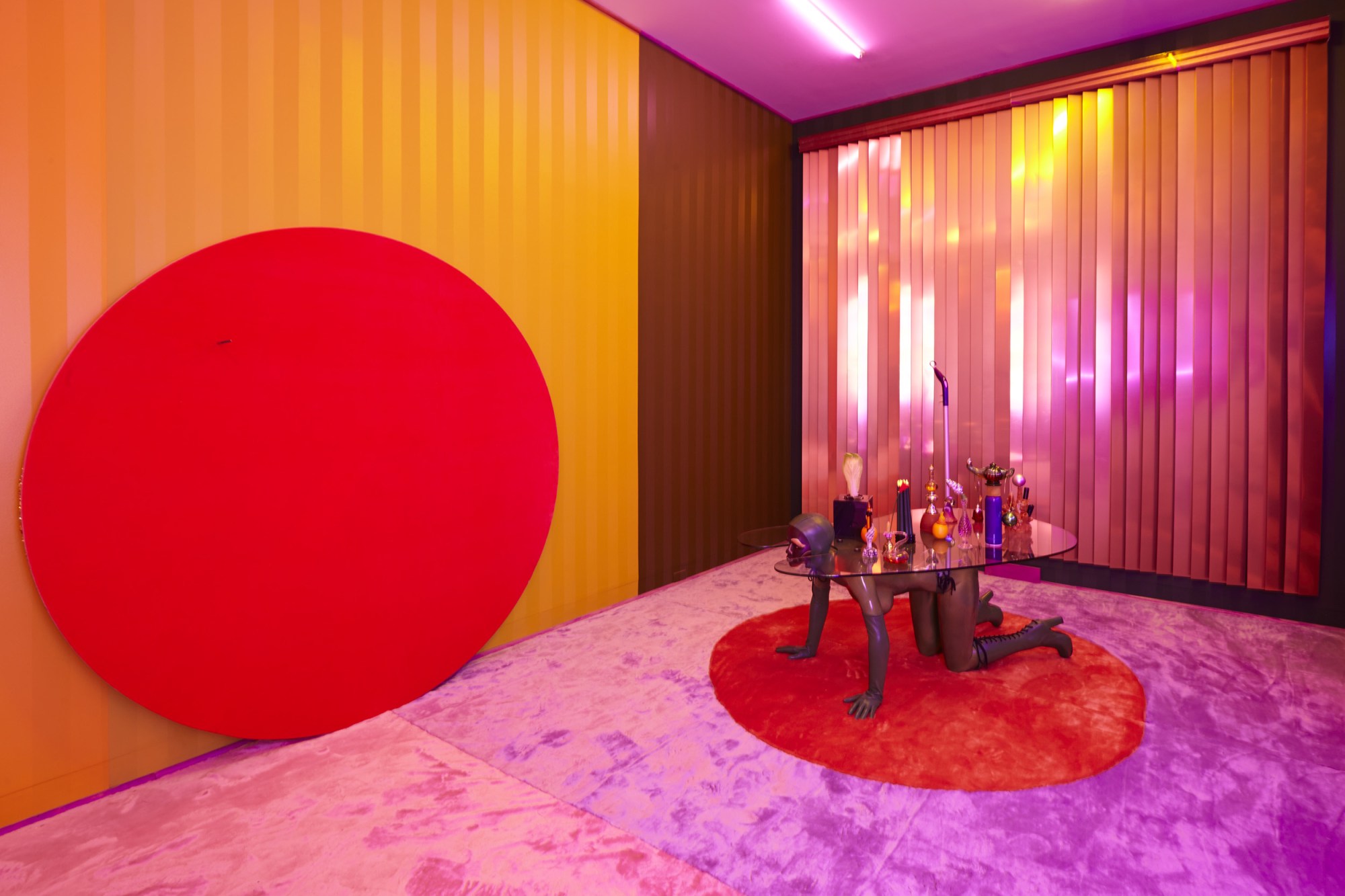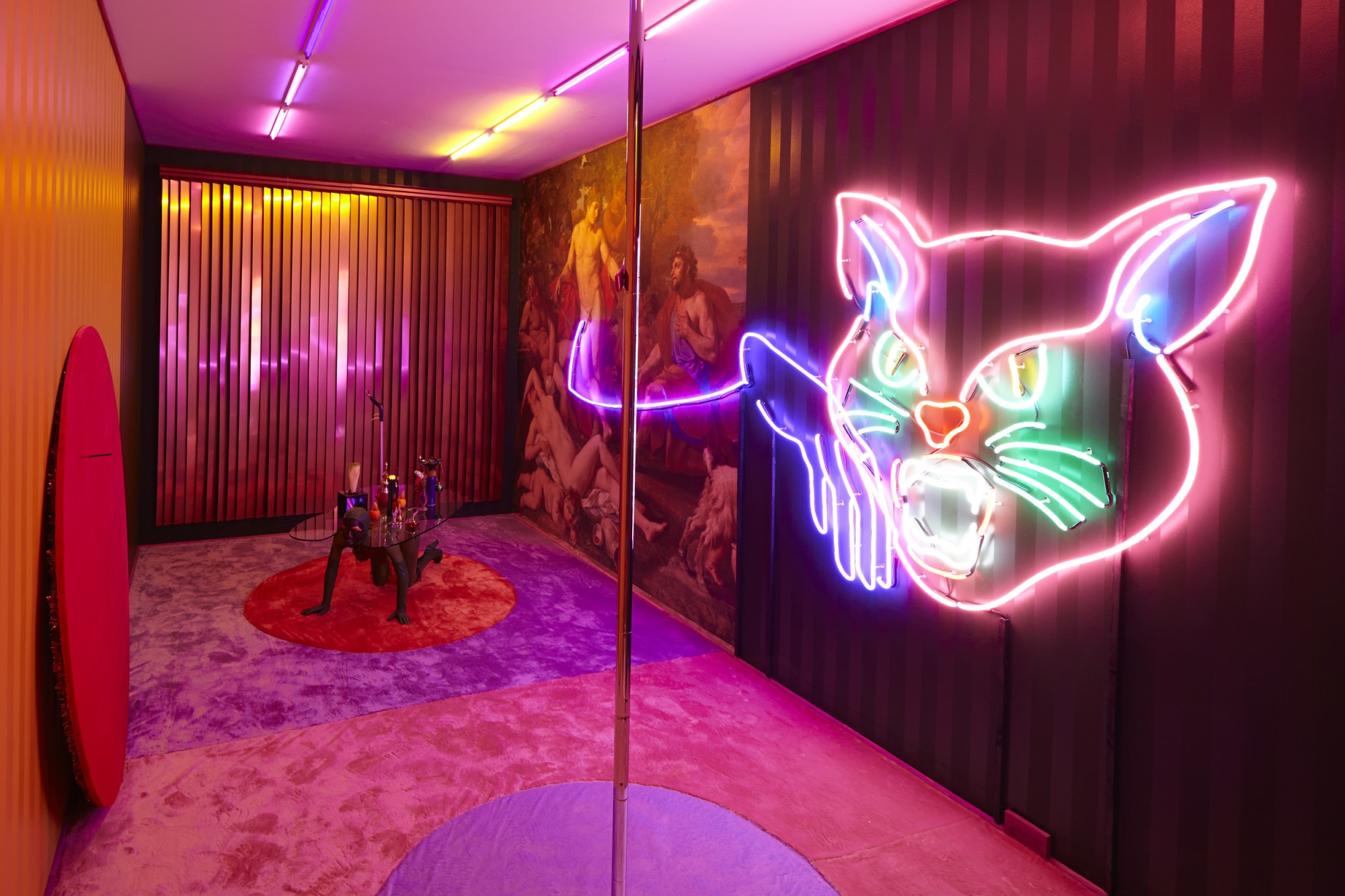New York’s narrowest townhouse is on 77th Street, one block east of Central Park. It used to be home to all four members of the Mamas and the Papas. Today though, it’s owned by the gallery Luxembourg & Dayan, which presented its latest exhibition in the space last night: a three-floor haunted house dreamed up by the Philadelphia-based artist Alex Da Corte.

After you knock on the door (using a tiny hand-shaped brass knocker straight out of Edgar Allan Poe), you walk in and up two narrow flights of stairs and through five rooms. Along the way you see wallpaper that changes color (or is it just the light?); a creaking, automated rocking chair; a stripper pole in a spotlight of plush mauve carpet; a reproduction of Poussin’s painting Midas and Bacchus; an actual Bjarne Melgaard table with a base that looks like a latex-clad submissive; and a pantry stacked with jars of mayo and homemade jam.
You may also recognize the smell of home (spices and cooking) or an old boyfriend (Calvin Klein Obsession).
Every element of the house, from the buzzing fluorescent lighting to the changing scents, is carefully controlled, and designed to disorient and manipulate. Being inside is like entering a dreamworld where the setting may shift at any moment from your grandmother’s house to a David Lynch set.
We caught up with Alex over the phone to talk about his interior decorating choices.

Although this is a solo exhibition, you integrated works by other artists. How did that dialogue work?
The work began as a walkthrough of the space, during which I planned out what kinds of feelings I wanted to experience as I traveled through the rooms — in relation to the architecture, colors and light. I was also thinking about the space in terms of the Mamas and the Papas (because they lived here) and I started thinking, “Who are the mothers and fathers of my work?” Which led me to Robert Gober, Bjarne Melgaard, Haim Steinbach and Mike Kelley. Then I chose specific works and began fleshing out how one Mike Kelley sculpture might relate to a feeling of anticipation and fear, or how one specific Melgard table relates to feelings about power, sex and desire.
How long did the installation take?
Five weeks. It was psychotic. If we had built the space in a white cube in my studio and transposed it into a gallery, it would have been done in a couple of days. But all the work happened on site. Everything in the show depends on lighting and architecture — the stuff that’s meant to go unnoticed is the stuff that has the most powerful effect on how one travels through the space. And all those things take time and experience.
As you enter the house, you’re given a printed script to follow, which doesn’t always reflect what you’re seeing. How did you intend the script and experience to relate?
A lot of my recent works have been immersive installations that play with time, cinema and how physical spaces can be made fluid. Constructing this particular installation in relation to a script, and then not having that script relate to what happens inside of the show, is a way to push and pull you away from what you’re actually looking at. If we’re thinking about the installation in terms of cinema, you’re the actor. And in the best case scenario, as the actor you have control. But in the worst case scenario, you are the actor so you’ll never see exactly what it looks like to be in that space.

The carpeted lounge feels especially cinematic.
It specifically refers to Rainer Werner Fassbinder’s film The Bitter Tears of Petra von Kant, which takes place in a single apartment — which interests me because of the sense of containment. The apartment in the film is decorated with a particular kind of Poussin wallpaper of King Midas and Bacchus, which I’ve used in the show, cropped to the exact same dimensions. But there are other, less specific, references to films too that paint a picture of a space we all recognize but have never visited.
How does the name of the show, Die Hexe, relate to being inside the space?
It’s a play on words. “Die hexe” is German for “the witch” but my intention was for those words to be said in English and pronounced phonetically. “Die” is “death of” and a “hex,” from Pennsylvanian Dutch, is a sign. So for me “die hexe” is “death of symbol.” I was thinking about dementia, when the reality a person has known deceives them and they have to recalibrate their brain and create something new. The same can be said of the works that I’ve borrowed: they have a particular symbolic meaning within art history and then [undergo] a reevaluation. This kind of logic is something that’s also embedded in dreams, when you have total freedom to rediscover how things function, like an alien from another planet.
Die Hexe is on display through April 11at Luxembourg & Dayan.
Credits
Text Alice Newell-Hanson
Photography by John Bernardo, courtesy of Luxembourg & Dayan, New York
